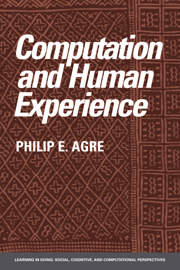Book contents
- Frontmatter
- Contents
- Preface
- 1 Introduction
- 2 Metaphor in practice
- 3 Machinery and dynamics
- 4 Abstraction and implementation
- 5 The digital abstraction
- 6 Dependency maintenance
- 7 Rule system
- 8 Planning and improvisation
- 9 Running arguments
- 10 Experiments with running arguments
- 11 Representation and indexicality
- 12 Deictic representation
- 13 Pengi
- 14 Conclusion
- Notes
- References
- Author index
- Subject index
12 - Deictic representation
Published online by Cambridge University Press: 07 December 2009
- Frontmatter
- Contents
- Preface
- 1 Introduction
- 2 Metaphor in practice
- 3 Machinery and dynamics
- 4 Abstraction and implementation
- 5 The digital abstraction
- 6 Dependency maintenance
- 7 Rule system
- 8 Planning and improvisation
- 9 Running arguments
- 10 Experiments with running arguments
- 11 Representation and indexicality
- 12 Deictic representation
- 13 Pengi
- 14 Conclusion
- Notes
- References
- Author index
- Subject index
Summary
Deictic intentionality
As the intellectual history sketched in Chapter 11 makes clear, AI research has been based on definite but only partly articulated views about the nature and purpose of representation. Representations in an agent's mind have been understood as models that correspond to the outside world through a systematic mapping. As a result, the meanings of an agent's representations can be determined independently of its zcurrent location, attitudes, or goals. Reference has been a marginal concern within this picture, either assimilated to sense or simply posited through the operation of simulated worlds in which symbols automatically connect to their referents. One consequence of this picture is that indexicality has been almost entirely absent from AI research. And the model-theoretic understanding of representational semantics has made it unclear how we might understand the concrete relationships between a representation-owning agent and the environment in which it conducts its activities.
In making such complaints, one should not confuse the articulated conceptions that inform technical practice with the reality of that practice. As Smith (1987) has pointed out, any device that engages in any sort of interaction with its environment will exhibit some kind of indexicality. For example, a thermometer's reading does not indicate abstractly “the temperature,” since it is the temperature somewhere, nor does it indicate concretely “the temperature in room 11,” since if we moved it to room 23 it would soon indicate the temperature in room 23 instead. Instead, we need to understand the thermometer as indicating “the temperature here” – regardless of whether the thermometer's designers thought in those terms.
- Type
- Chapter
- Information
- Computation and Human Experience , pp. 241 - 259Publisher: Cambridge University PressPrint publication year: 1997
- 1
- Cited by



